Technique Secrets
Constantly Updated
I still have not figured out exactly why but even maestros who are often referred to as "Great", hold on to the little tips and secrets which would definitely open up new horizons and hopes to our playing-performing efforts. Selfishness, and insecurity are definitely part of the equation. In a way, some of these teachers, hold on to these tips as magicians hold on to their illusions. Well, I decided to break up with all this nonsense!
There is actually a lot of illusion involved in mastering an instrument, and just like a great magician will point our attention to the obvious (the way he/she holds the guitar, plucks the strings, etc) the maestros will voluntarialy-involuntarialy keep our focus away from the core. These technical tips are often mentioned but it is not emphasized how important a role they play. I am still in the process of digging out more of these but I will list here the ones I picked-up through the years. My sources are observation, reading --especially what pianists and violinists have written-- the seldom generous give-away of teachers, and countless hours of my own trial and error practice sessions.
Be brave and break every conventional rule if your intelligence is there to back you up. Eventually, you will be using the so hardly sought after technique that best works for you: Your technique. As you read through the master playing commandments below, you will come to realize that they all make perfect sense. That is the signature of truth.
Following are my 25 guitar playing Commandments. They are all essential.
1. Learn to incorporate the word breathing in the score, actually write it down and make it part of the memorizing process. Make sure the breathing comes just before technically challenging parts. Good breathing makes for 40 percent of effortless (if such a thing exists) playing and relaxation especially during public performances. A good way to breath is inhale counting 1, 2 slowly, holding on to the breath for about 4 seconds and exhale counting 1, 2. This is tricky to master at first but comes naturally and instinctive with time. During performance, a simpler breathing technique may be used: exhale counting 1-2. Exhaling means to expel the CO2 from our system. It is harder to do than inhale. Formula: The less CO2 in your blood, the better your playing.
2. Keep the left hand thumb with as little pressure as possible and with no pressure at all very often and whenever you can. We tend to press hard with bars because we think that pressure is the key. False, finger 1 position and guitar holding position are. The left hand thumb is hidden behind the fret board and it is difficult to glimpse its action both in concerts and video. Still, it is often here where the real magic of effortless playing rests. Most players use 3 times more left hand fingers pressure than necessary. Masters use just enough.
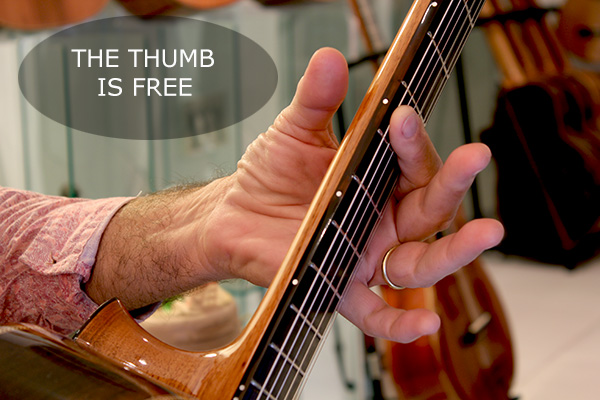
3. Use open strings every chance you can and create the sound with your right hand and not with a given string.
4. Avoid the 2-3 left hand combination in scales and slurs. 2-4 works a lot better. This is due to the human anatomy of the hands. If you look at a player's left hand you will notice that finger 2 and 3 are usually very close together and allow for minimal stretching and coordination.
5. Keep your chin away from the chest and your head slightly forward -posture- and work on being very much aware of this key element of relaxation during practice. Again, you may need to write it down every few staffs on the score. Be aware of your level of tension or relaxation during practice. You will have to master relaxation during practice.
6. Feel the strings with your right hand fingers flesh before actually plucking them. The sense of touch is the equivalent of sight and it is in the right hand where most of our playing mistakes originate. This applies to every aspect of playing but especially for arpeggios, scales and tremolo. It is often referred to as "planting" the finger. I prefer to call it "feeling" the string.
7. When trying to learn a piece by memory, simply play it with the score until you feel the score is simply there. Then, gradually, start turning to your hands until the score is unnecessary. In other words, you want as much of the score to be recorded, even if only at a subconscious level, before putting it away. (It takes approximately 60 score readings to memorize a piece). Some musicians have an outstanding memory. Needless to say, if you are one of those, the whole process is practically effortless.
8. When the left hand goes into a more stressing position, do not automatically stress your right hand (this is a natural reflex) that goes unnoticed most of time. Remember that the right hand is the one that really regulates the stress level (for left handed players, the opposite is true). Do a stress check every few seconds during performance and send the command "relax" when you notice tension in any part of the body (typically the right leg, shoulders and lower back).
9. The metronome MUST always be used during practice. It will put a magnifying glass on your playing and no mistake or technique defect will be able to hide from you.
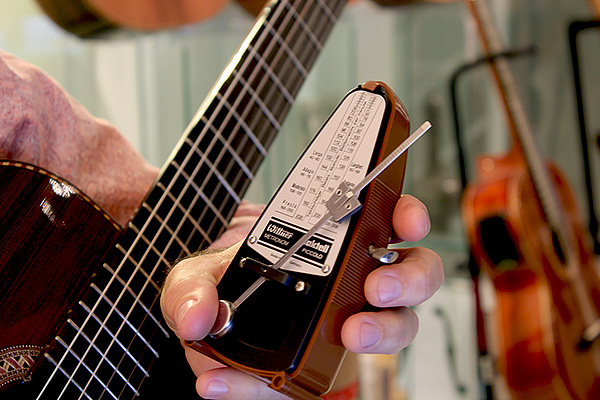
10. The right hand is the source of most mistakes and not the left hand. You must play every measure with the metronome.
11. Put your eyes there first! You should be looking at the position you will be moving to a fraction of a second before you actually do the movement. In the 1996 concert in Germany (animation below), Maestro Carlevaro gets his eyes on fret 9 before moving his left hand there.
12. Finger the tricky parts backwards. Fingering must flow both ways and logical fingerings often "stick out" this way.
13. A two fingers vibrato often delivers better than a one finger vibrato.
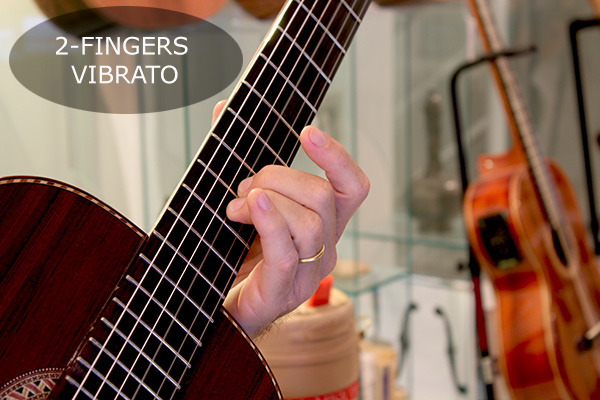
14. The left hand commands. 1-The left hand fingers are in place, 2- Feel the strings with the right hand fingers, 3- Play. Whenever the right hand commands you are more likely to make mistakes.
15. "Practice Makes Perfect?" - Not always! Every good musician knows that regular practice is a must, but careless practice can actually make you worse.
16. Work on the most challenging spots first.
17. Practice only on the days that you eat.
18. In order to avoid cutting a musical phrase when fingering, avoid position changes to coincide with important parts of the phrase.
19. It is ok not to play all the notes in extremely fast or demanding parts of a piece as long as the direction of the phrase is kept intact (rhythmic precision and sense of direction are more important than precision).
20. Shift difficulties between right and left hand when fingering. The load is lighter if shared by both hands.
21. When a musical phrase includes a change in position, avoid putting stress on the first note of the new position. You will disguise the position change better this way. Look for the most convenient place to make the change both musically and technically.
22. It is okay to fret notes with the pads of the left hand fingers. I'm not suggesting this be done deliberately, for the fretting of every note. Just that it is okay when it happens.
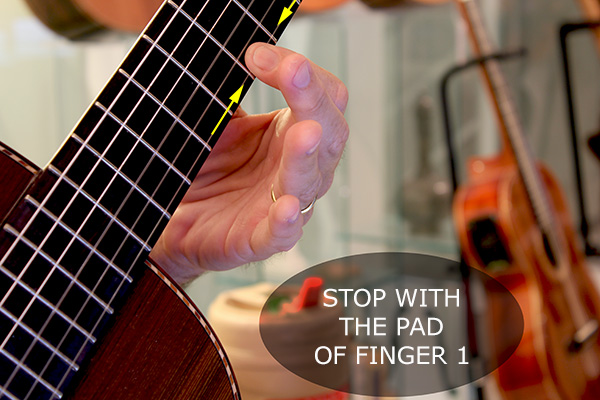
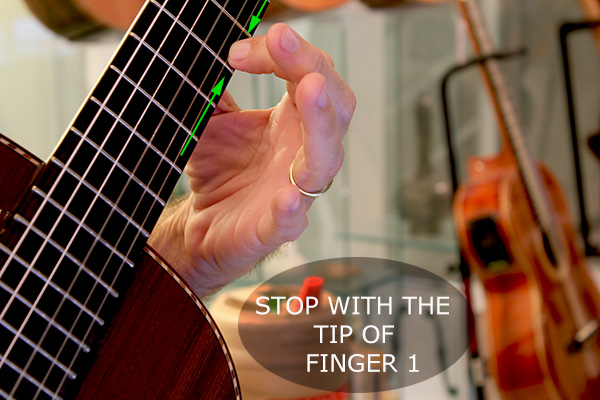
23. It is okay for left hand fingers (even right hand fingers) to lean against strings that are not being plucked.
24. It is perfectly ok to use the same right hand finger to play a series of consecutive notes especially when the sound we desire is produced only by one of the RH fingers. I know a Japanese player who plays tremolo using his right hand little finger only and, believe me, he is a great performer.
25. An i-a combination is sometimes more reliable than an i-m combination especially during scales. The length of fingers i and a is almost the same as opposed to the length of fingers i and m or m and a which are radically different. Try different right hand fingering combinations during scales and incorporate the use of the thumb in scales.
The continuation of this class is in the members area, become a member today.
 Back to Top
Back to Top



